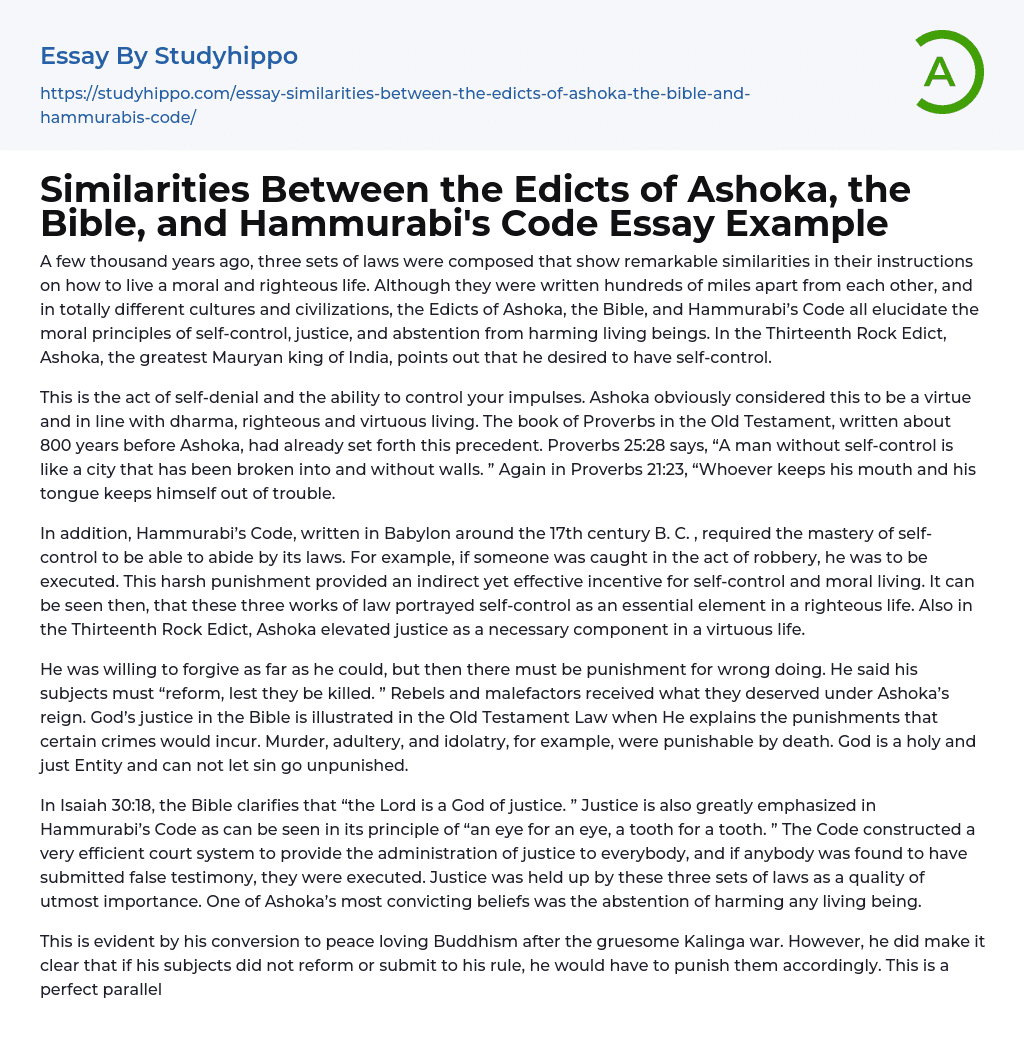

Similarities Between the Edicts of Ashoka, the Bible, and Hammurabi’s Code Essay Example
A few thousand years ago, three sets of laws were composed that show remarkable similarities in their instructions on how to live a moral and righteous life. Although they were written hundreds of miles apart from each other, and in totally different cultures and civilizations, the Edicts of Ashoka, the Bible, and Hammurabi’s Code all elucidate the moral principles of self-control, justice, and abstention from harming living beings. In the Thirteenth Rock Edict, Ashoka, the greatest Mauryan king of India, points out that he desired to have self-control.
This is the act of self-denial and the ability to control your impulses. Ashoka obviously considered this to be a virtue and in line with dharma, righteous and virtuous living. The book of Proverbs in the Old Testament, written about 800 years before Ashoka
..., had already set forth this precedent. Proverbs 25:28 says, “A man without self-control is like a city that has been broken into and without walls. ” Again in Proverbs 21:23, “Whoever keeps his mouth and his tongue keeps himself out of trouble.
In addition, Hammurabi’s Code, written in Babylon around the 17th century B. C. , required the mastery of self-control to be able to abide by its laws. For example, if someone was caught in the act of robbery, he was to be executed. This harsh punishment provided an indirect yet effective incentive for self-control and moral living. It can be seen then, that these three works of law portrayed self-control as an essential element in a righteous life. Also in the Thirteenth Rock Edict, Ashoka elevated justice as a necessary component in a virtuous life.
He
was willing to forgive as far as he could, but then there must be punishment for wrong doing. He said his subjects must “reform, lest they be killed. ” Rebels and malefactors received what they deserved under Ashoka’s reign. God’s justice in the Bible is illustrated in the Old Testament Law when He explains the punishments that certain crimes would incur. Murder, adultery, and idolatry, for example, were punishable by death. God is a holy and just Entity and can not let sin go unpunished.
In Isaiah 30:18, the Bible clarifies that “the Lord is a God of justice. ” Justice is also greatly emphasized in Hammurabi’s Code as can be seen in its principle of “an eye for an eye, a tooth for a tooth. ” The Code constructed a very efficient court system to provide the administration of justice to everybody, and if anybody was found to have submitted false testimony, they were executed. Justice was held up by these three sets of laws as a quality of utmost importance. One of Ashoka’s most convicting beliefs was the abstention of harming any living being.
This is evident by his conversion to peace loving Buddhism after the gruesome Kalinga war. However, he did make it clear that if his subjects did not reform or submit to his rule, he would have to punish them accordingly. This is a perfect parallel with God in the Old Testament. God included “thou shalt not murder” in the Ten Commandments as a law for the Israelites and the rest of the world to follow, but it is apparent in other places of the Bible that God
has holy wrath and must punish the people who rebel against Him with eternal death.
There are also many instances in the Bible where God has ordered the Israelites to go to war and not spare anyone. Hammurabi’s Code showed some kindness in that it allows for cases of high importance to be appealed directly to the king. Hammurabi himself also demonstrated that he did not want harm to come to his subjects by openly involving himself in even the smallest affairs of his kingdom. Therefore, the Bible and Hammurabi’s Code show that they respected life as much as the Edicts of Ashoka.
In conclusion, it is clear that the Edicts of Ashoka are analogous to the Bible and Hammurabi’s Code on the importance of self-control, justice, and the abstention of harming living beings. They all set forth guidelines concerning how a person is to live a moral and righteous life, but they also explain the punishments for those who do not obey. These three sets of laws are timeless in their content, and are still looked upon today as the foundation for modern laws.
- Jurisprudence essays
- Social Injustice essays
- Juvenile Justice essays
- Business Law essays
- Contract essays
- Consumer Protection essays
- Property essays
- Ownership essays
- Agreement essays
- Common Law essays
- Contract Law essays
- Justice essays
- Security essays
- Tort Law essays
- United States Constitution essays
- Crime essays
- Lawsuit essays
- Treaty essays
- Family Law essays
- Marijuana Legalization essays
- Constitution essays
- War on Drugs essays
- Court essays
- Jury essays
- Police essays
- Protection essays
- Community Policing essays
- Criminal Law essays
- Judge essays
- Lawyer essays
- Employment Law essays
- Copyright Infringement essays
- Injustice essays
- Intellectual Property essays
- Breach Of Contract essays
- Internet Privacy essays
- Cyber Security essays
- Bill Of Rights essays
- Civil Liberties essays
- First Amendment To The United States Constitution essays
- Fourth Amendment To The United States Constitution essays
- Second amendment essays
- Animal Cruelty essays
- Law Enforcement essays
- Juvenile Justice System essays
- Surveillance essays
- Forensic Science essays
- Crime Prevention essays
- Criminal Justice essays
- Criminology essays



